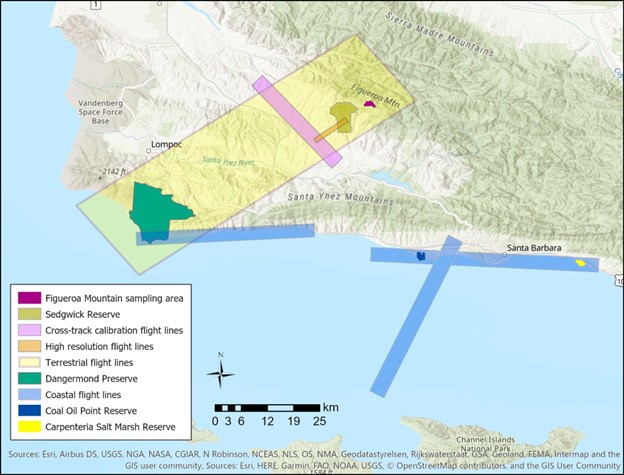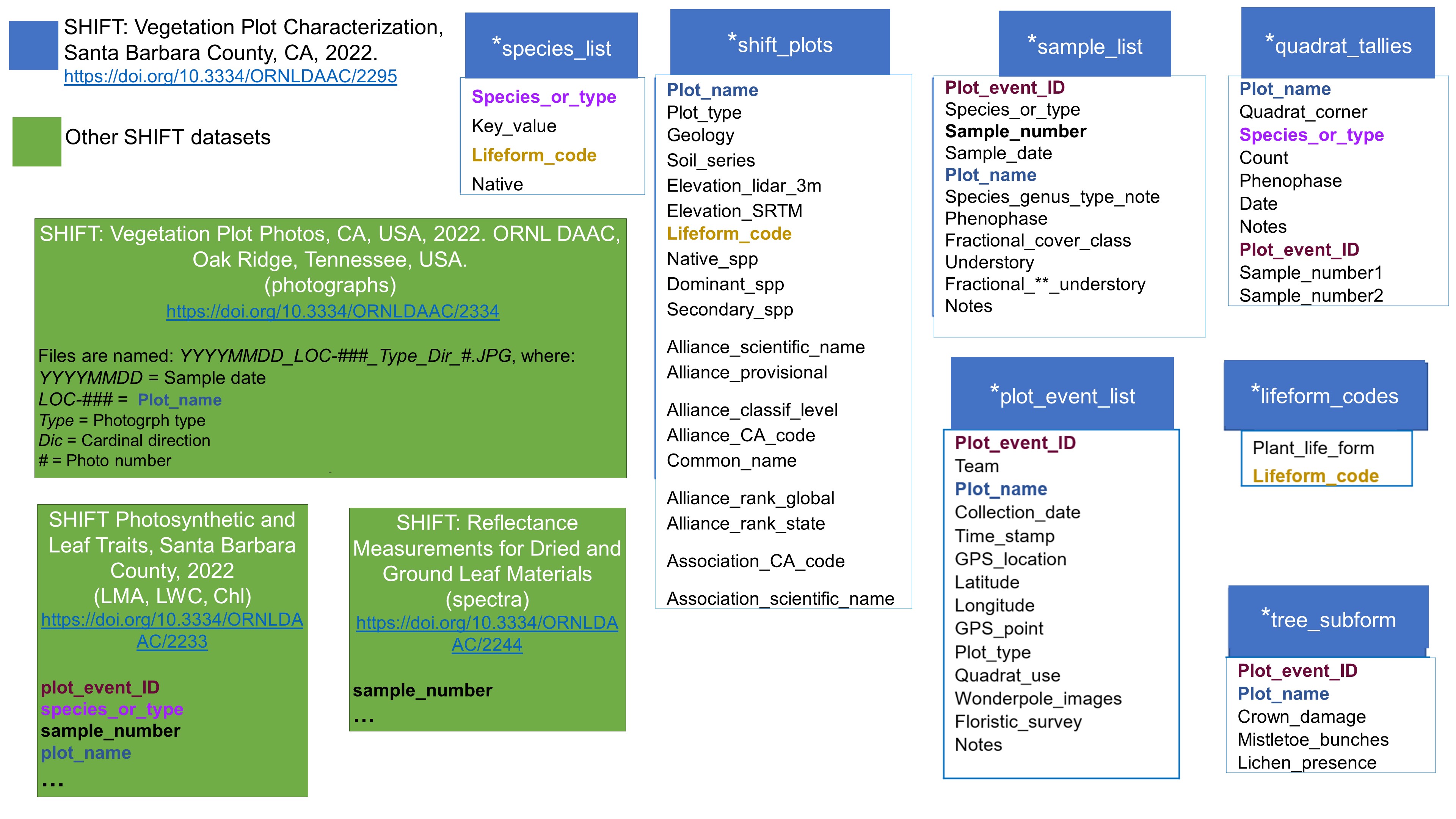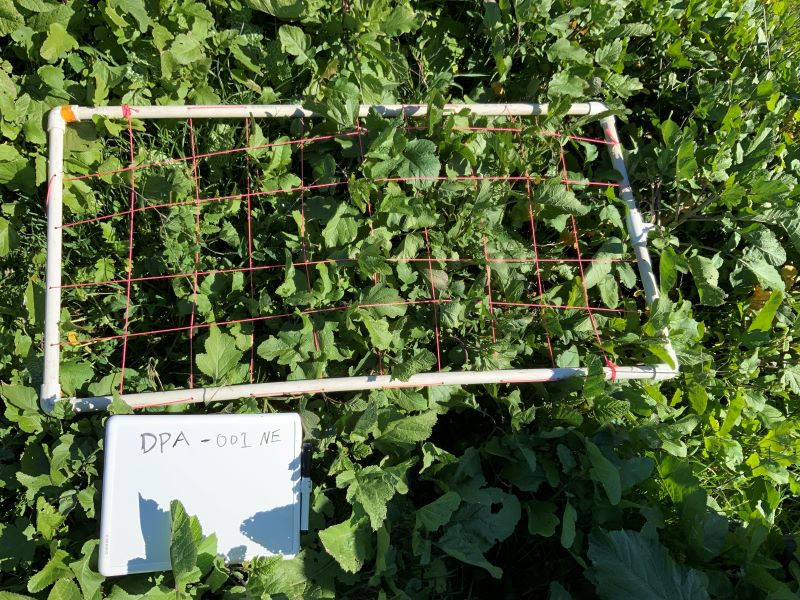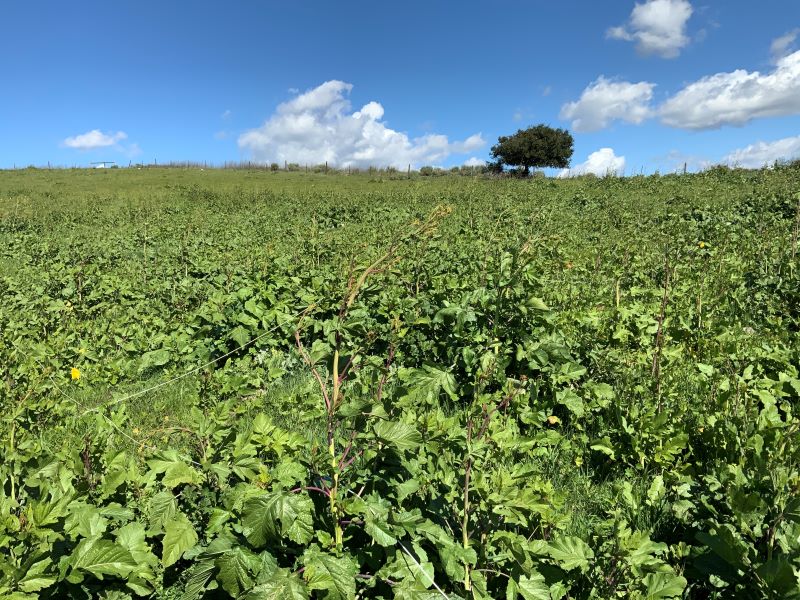Documentation Revision Date: 2025-03-10
Dataset Version: 1
Summary
This dataset includes 4,772 files in JPEG image format and two files in MP4 video format.

Figure 1: Map of the SHIFT study area in Santa Barbara County, California showing the Jack and Laura Dangermond Preserve, Sedgwick Reserve, and Figueroa Mountain sampling areas and AVIRIS-NG coverage by coastal and terrestrial flightlines. The base map distinguishes public lands (green shaded) from private lands. Figure from Chadwick et al. (in review).
Citation
Queally, N., F.W. Davis, K.D. Chadwick, C. Ade, L. Anderegg, Y. Angel, B. Baker, L. Baskaran, I. Boving, R.K. Braghiere, P. Brodrick, P. Campbell, J. Cryer, K.C. Cushman, P.D. Dao, A. Dibartolo, R. Eckert, K. Grant, B. Heberlein, M. Johnson, J. Joutras, K. Kerr, C. Kibler, M. Klope, K. Kovach, A. Kreisberg, P. Lovegreen, A.J. Maguire, C.A. Mcmahon, K. Miner, C. Nickles, F. Ochoa, J.P. Ocón, A. Ongjoco, E.M. Ordway, M. Park, R. Pavlick, A.M. Raiho, D.A. Roberts, C.M. Saiki, F.D. Schneider, K. Thompson, P.A. Townsend, E. Vermeer, C. Villanueva-Weeks, N. Vinod, T. Zheng, K. Zumdahl, and D.S. Schimel. 2024. SHIFT: Vegetation Plot Photos, Santa Barbara, CA, USA, 2022. ORNL DAAC, Oak Ridge, Tennessee, USA. https://doi.org/10.3334/ORNLDAAC/2334
Table of Contents
- Dataset Overview
- Data Characteristics
- Application and Derivation
- Quality Assessment
- Data Acquisition, Materials, and Methods
- Data Access
- References
Dataset Overview
This dataset contains photographs of the plots where field vegetation sampling was conducted during the 2022 NASA Surface Biology Geology (SBG) High Frequency Time series (SHIFT) campaign. Sampling occurred at the Jack and Laura Dangermond Preserve, Sedgwick Reserve, and Carpinteria Salt Marsh Reserve, which are located in Santa Barbara County, California, USA. Photographs were taken from 2022-02-23 to 2022-09-18. This project collected field data contemporaneously with weekly flights of Airborne Visible-Infrared Imaging Spectrometer-Next Generation (AVIRIS-NG) over the study areas. Subsequent data packages will contain additional biogeochemical, reflectance, and foliar data as they become available.
This dataset contains images collected during the same sampling activity of the dataset: Queally et. al. SHIFT: Vegetation Plot Characterization, Santa Barbara County, CA, Version 2, 2022. ORNL DAAC, Oak Ridge, Tennessee, USA. https://doi.org/10.3334/ORNLDAAC/2386
Project: Surface Biology and Geology High-Frequency Time Series (SHIFT)
The Surface Biology and Geology (SBG) High Frequency Time Series (SHIFT) was an airborne and field campaign during February to May, 2022, with a follow up activity for one week in September, in support of NASA's SBG mission. Its study area included a 640-square-mile (1,656-square-kilometer) area in Santa Barbara County and the coastal Pacific waters. The primary goal of the SHIFT campaign was to collect a repeated dense time series of airborne Visible to ShortWave Infrared (VSWIR) airborne imaging spectroscopy data with coincident field measurements in both inland terrestrial and coastal aquatic areas, supported in part by a broad team of research collaborators at academic institutions. The SHIFT campaign leveraged NASA's Airborne Visible-Infrared Imaging Spectrometer-Next Generation (AVIRIS-NG) facility instrument to collect approximately weekly VSWIR imagery across the study area. The SHIFT campaign 1) enables the NASA SBG team to conduct traceability analyses related to the science value of VSWIR revisit without relying on multispectral proxies, 2) enables testing algorithms for consistent performance over seasonal time scales and end-to-end workflows including community distribution, and 3) provides early adoption test cases to SHIFT application users and incubate relationships with basic and applied science partners at the University of California Santa Barbara Sedgwick Reserve and The Nature Conservancy's Jack and Laura Dangermond Preserve.
Related Publication:
Chadwick, K.D., F. Davis, K.R. Miner, R. Pavlick, M. Reynolds, P.A. Townsend, P.G. Brodrick, C. Ade, J. Allen, L. Anderegg, Y. Angel, I. Boving, K.B. Byrd, P. Campbell, L. Carberry, K.C. Cavanaugh, K. Easterday, R. Eckert, M. Gierach, K. Gold, E. Hestir, F. Huemmrich, M. Klope, R. Kokaly, P. Lovegreen, K. Luis, C. McMahon, N. Nidzieko, F. Ochoa, A. Jiselle Ongjoco, E. Ordway, M. Pascolini-Campbell, N. Queally, D.A. Roberts, C.M. Saiki, F.D. Schneider, A.N. Shiklomanov, G.D. Silva, J. Snyder, M. Thornton, A. Trugman, N. Vinod, T. Zheng, D.M. Avouris, B. Baker, L. Baskaran, T. Bell, M. Berg, M. Bernas, N. Bohn, R.K. Braghiere, Z. Breuer, A.J. Brooks, N. Burkard, K. Cawse-Nicholson, J. Chapman, J. Chazaro-Haraksin, J. Cryer, K.C. Cushman, K. Dahlin, P.D. Dao A. DiBartolo, M. Eastwood, C. Elder, A. Giordani, K. Grant, R.O. Green, A. Hanson, B. Heberlein, M. Helmlinger, S. Hook, D. Jensen, E. Johnson, M. Johnson, M. Kiper, C. Kibler, J.Y. King, K.R. Kovach, A. Kreisberg, D. Lacey, E. Lang, C. Lee, A.M. Lopez, B. Lopez Barreto, A. Maguire, E. Marsh, C. Miller, D.M.T. Nguyen, C. Nickles, J.P. Ocón, E.P. Papen, M. Park, B. Poulter, A. Raiho, P. Reim, T.H. Robinson, F.E. Romero Galvan, E. Shafron, S. Stroschein, N.C. Taylor, D.R. Thompson, K. Thompson, C. Tye, J. Van Beek, C. Vanden Heuvel, J. Vellanoweth, E. Vermeer, C. Villanueva-Weeks, K. Zumdahl, D. Schimel. Unlocking Ecological Insights from Subseasonal Visible-to-Shortwave Infrared Imaging Spectroscopy: The SBG High Frequency Time Series (SHIFT) Campaign. [Manuscript in review.]
Related Data Sets:
Queally, N., F.W. Davis, K.D. Chadwick, C. Ade, L. Anderegg, Y. Angel, B. Baker, I. Boving, R.K. Braghiere, P. Brodrick, P. Campbell, J. Cryer, K.C. Cushman, P.D. Dao, A. Dibartolo, R. Eckert, K. Grant, B. Heberlein, M. Johnson, J. Joutras, K. Kerr, C. Kibler, M. Klope, K. Kovach, A. Kreisberg, P. Lovegreen, A.J. Maguire, C.A. Mcmahon, K. Miner, C. Nickles, F. Ochoa, J.P. Ocón, A. Ongjoco, E.M. Ordway, M. Park, R. Pavlick, A.M. Raiho, D.A. Roberts, C.M. Saiki, F.D. Schneider, K. Thompson, P.A. Townsend, E. Vermeer, C. Villanueva-Weeks, N. Vinod, T. Zheng, K. Zumdahl, and D.S. Schimel. 2025. SHIFT: Vegetation Plot Characterization, Santa Barbara County, CA, Version 2, 2022. ORNL DAAC, Oak Ridge, Tennessee, USA. https://doi.org/10.3334/ORNLDAAC/2386
- Provides SHIFT plot locations, descriptions, species, fractional cover, phenophase, and sample identifier data. Plot identifiers are consistent across datasets.
Chadwick, K.D., N. Queally, T. Zheng, J. Cryer, C. Vanden Heuvel, C. Villanueva-Weeks, C. Ade, L. Anderegg, Y. Angel, B. Baker, I. Boving, R.K. Braghiere, P. Brodrick, P. Campbell, K.C. Cushman, F. Davis, P.D. Dao, A. Dibartolo, R. Eckert, K. Grant, B. Heberlein, M. Johnson, J. Joutras, C. Kibler, M. Klope, K. Kovach, A. Kreisberg, P. Lovegreen, A.J. Maguire, C. Mcmahon, K. Miner, C. Nickles, F. Ochoa, J.P. Ocón, A. Ongjoco, E. Ordway, M. Park, R. Pavlick, A.M. Raiho, D.A. Roberts, D.S. Schimel, F.D. Schneider, K. Thompson, P. Townsend, E. Vermeer, N. Vinod, and K. Zumdahl. 2023. SHIFT Photosynthetic and Leaf Traits, Santa Barbara County, 2022. ORNL DAAC, Oak Ridge, Tennessee, USA. https://doi.org/10.3334/ORNLDAAC/2233
- Provides leaf images and measurements of leaf traits (area, wet weight, dry weight, leaf mass per area, leaf water content) and leaf pigments (chlorophyll) and species information
Zheng, T., N. Queally, K.D. Chadwick, J. Cryer, P. Reim, P. Townsend, E. Marsh, M. Berg, Z. Breuer, N. Burkard, A. Hanson, E. Johnson, D. Lacey, A. Lee, L. Pfau, I. Shifrin, B. Skalitzky, S. Stroschein, J. Van beek, C. Vanden heuvel, and A. Williams. 2023. SHIFT: Reflectance Measurements for Dried and Ground Leaf Materials. ORNL DAAC, Oak Ridge, Tennessee, USA. https://doi.org/10.3334/ORNLDAAC/2244
- Provides spectra of dried and ground leaf material
Data Characteristics
Spatial Coverage: Plots within Dangermond Preserve, Sedgwick Reserve, and Carpinteria Salt Marsh Reserve within Santa Barbara County. California, USA
Spatial Resolution: Point measurements
Temporal Coverage: 2022-02-23 to 2022-09-18
Temporal Resolution: One-time measurements
Study Areas: Latitude and longitude are given in decimal degrees.
|
Site |
Westernmost Longitude |
Easternmost Longitude |
Northernmost Latitude |
Southernmost Latitude |
|
Dangermond Preserve |
-120.50 |
-120.35 |
34.58 |
34.44 |
|
Sedgwick Reserve |
-120.07 |
-120.01 |
34.74 |
34.68 |
|
Carpinteria Salt Marsh Reserve |
-119.55 |
-119.52 |
34.41 |
34.39 |
Data File Information
This dataset contains photographs of the plots where field vegetation sampling was conducted during the 2022 NASA Surface Biology Geology (SBG) High Frequency Time series (SHIFT) campaign in Santa Barbara County, California, USA. It includes 4772 photographs in JPEG (*.jpg) image format and two files in MP4 (*.mp4) video format.
The JPEG image files are named as YYYYMMDD_LOC-###_Type_Dir_#.JPG where:
- YYYYMMDD is the sampling date.
- LOC-### is the Plot ID. The first two letters are associated with the site name. “DP”= Dangermond Preserve, “SR”= Sedgwick Preserve, and “CS”= Carpinteria Salt Marsh Reserve. The Plot ID variable is a unique identifier across some other SHIFT datasets, please see Figure 2.
- Type is the photograph type.
- “land” is a landscape photograph of the plot.
- “misc” are miscellaneous images.
- “tree” are tree plots.
- “qdata” are the quadrat survey sheets.
- “quad” is for herbaceous plots with the gridded quadrat placed.
- “specid” is taken of a plant for identification purposes.
- “wp” is an image taken from a Wonderpole to capture an overhead view of the plot.
- Dir is the compass direction of the plot corner or quadrant with respect of plot center.
- # is used to differentiate when multiple photographs of a specific type were taken. E.g. 20220223_DPA-001_quad_SE_1.jpg and 20220223_DPA-001_quad_SE_2.jpg.
The two MP4 video files are named 20220413_misc_12.MP4 and 20220915_misc_2.MP4.
This dataset contains images collected during the same sampling activity of the dataset: Queally et. al. SHIFT: Vegetation Plot Characterization, Santa Barbara County, CA, Version 2, 2022. ORNL DAAC, Oak Ridge, Tennessee, USA. https://doi.org/10.3334/ORNLDAAC/2386

Figure 2. SHIFT vegetation plot survey data field crosswalk.
Application and Derivation
Data were collected for the SHIFT campaign to support the SBG mission and to provide information on plant communities over a large region of Santa Barbara County, California including field sampling activity to collect vegetation and plot characteristic data to coincide with the timing of the weekly AVIRIS-NG flights.
Quality Assessment
These photographs serve as records and vouchers and to add context to data collected during vegetation sampling. Survey data are available in Queally et al. (2025)
Data Acquisition, Materials, and Methods
The image files provided in this dataset were collected during the field vegetation sampling efforts for the SHIFT project in 2022.
Study sites: Study sites were located in Santa Barbara County, California to coincide spatiotemporally with weekly overflights by NASA's Airborne Visible-Infrared Imaging Spectrometer-Next Generation (AVIRIS-NG). Sites selected for sampling had high vegetative cover and homogeneous characteristics relative to the immediately surrounding area. In addition, within a sampling area we selected a set of sites that represented a range of species and species assemblages. Grassland and low shrub plots were set up as square 8 m x 8 m plots with four quadrants. Trees and tall shrubs were set up as the extent of the individual crown.
Methodology:
Sample Site Metadata Collection
Vegetation and plot characteristic data were sampled three days a week in order to match with that week’s image acquisition. A field team of 45 individuals (around 10 per day) organized into 2-3 teams conducted physical sample collection of a mixture of grass, shrub, and tree plots. Teams assessed fractional cover using quadrats and conducted a floristic survey of all species occurring in the plot. Teams collected high-accuracy GPS data using a Trimble Geo 7x, with an accuracy of ~25 cm, for the plot center or a designated corner of the plot. The plot perimeter was collected using a lower-accuracy GPS-enabled iPad with TouchGIS, typically accurate to within 3-15 m depending on canopy openness (see reference). Each sample received a unique sample number that was linked to the unique plot name.
Photographs were taken during vegetation sampling. A floristic survey was conducted in which all present species in the plot were noted along with their phenophase and relative percent cover as seen from above. For grassland and low shrub plots, photographs of each quadrant were taken from above using a Wonderpole (“wp” photographs). For grassland plots alone, fractional cover in each quadrant was assessed using a gridded 0.5-m x 1-m quadrat with 50 cells. These quadrants were also photographed (“quad” photographs; e.g., Figure 2). For tree plots, photographs of the overstory and understory (“tree” photographs) were taken. If a species within a plot covered at least 20% of the plot (estimated as seen from the plane), a physical sample was collected and identified to species. If flowers, seeds, or senescent vegetation met this same threshold, those materials were collected as a separate sample. Additionally, photographs of the landscape (“land” photographs; e.g., Figure 3) and gridded quadrat data collection sheets (“qdata” phorographs) were taken. Wonderpole photographs were taken with a Sony ILCE-5100 camera. All other photographs were taken with either an Apple iPhone or iPad.
Sample Site Polygon Generation
With the combined use of the high-accuracy GPS data and the GPS perimeters recorded in the iPad software based on the preliminary imagery received from the SHIFT data team, polygons that represent the spatial extent of each sampling site were generated. For the grassland and low shrub plots, GPS coordinates were collected from one designated corner followed by walking the 8-m x 8-m perimeter to define the polygon. For tall shrubs and trees, the extent of the crown for the sampled individual was outlined. This method allows for the selection of all pixels that are associated with the plot, rather than selecting an arbitrary distance from the GPS point that was collected. A team of SHIFT participants manually assessed each plot shapefile in post-processing and aligned the plot extent using the SHIFT imagery from the associated flight date for that particular plot to ensure the extraction of the correct pixels for each date. As such, the precise location of these shapefiles may be offset from other data products and should be evaluated accordingly.

Figure 3. Example photograph of quadrant sample at the Dangermond Preserve, Santa Barbara County, California. Source: 20220223_DPA-001_quad_NE.JPG

Figure 4. Example landscape photograph taken at the Dangermond Preserve, Santa Barbara County, California. Source: 20220223_DPA-001_land.JPG
Data Access
These data are available through the Oak Ridge National Laboratory (ORNL) Distributed Active Archive Center (DAAC).
SHIFT: Vegetation Plot Photos, Santa Barbara, CA, USA, 2022
Contact for Data Center Access Information:
- E-mail: uso@daac.ornl.gov
- Telephone: +1 (865) 241-3952
References
Chadwick, K.D., F. Davis, K.R. Miner, R. Pavlick, M. Reynolds, P.A. Townsend, P.G. Brodrick, C. Ade, J. Allen, L. Anderegg, Y. Angel, I. Boving, K.B. Byrd, P. Campbell, L. Carberry, K.C. Cavanaugh, K. Easterday, R. Eckert, M. Gierach, K. Gold, E. Hestir, F. Huemmrich, M. Klope, R. Kokaly, P. Lovegreen, K. Luis, C. McMahon, N. Nidzieko, F. Ochoa, A. Jiselle Ongjoco, E. Ordway, M. Pascolini-Campbell, N. Queally, D.A. Roberts, C.M. Saiki, F.D. Schneider, A.N. Shiklomanov, G.D. Silva, J. Snyder, M. Thornton, A. Trugman, N. Vinod, T. Zheng, D.M. Avouris, B. Baker, L. Baskaran, T. Bell, M. Berg, M. Bernas, N. Bohn, R.K. Braghiere, Z. Breuer, A.J. Brooks, N. Burkard, K. Cawse-Nicholson, J. Chapman, J. Chazaro-Haraksin, J. Cryer, K.C. Cushman, K. Dahlin, P.D. Dao A. DiBartolo, M. Eastwood, C. Elder, A. Giordani, K. Grant, R.O. Green, A. Hanson, B. Heberlein, M. Helmlinger, S. Hook, D. Jensen, E. Johnson, M. Johnson, M. Kiper, C. Kibler, J.Y. King, K.R. Kovach, A. Kreisberg, D. Lacey, E. Lang, C. Lee, A.M. Lopez, B. Lopez Barreto, A. Maguire, E. Marsh, C. Miller, D.M.T. Nguyen, C. Nickles, J.P. Ocón, E.P. Papen, M. Park, B. Poulter, A. Raiho, P. Reim, T.H. Robinson, F.E. Romero Galvan, E. Shafron, S. Stroschein, N.C. Taylor, D.R. Thompson, K. Thompson, C. Tye, J. Van Beek, C. Vanden Heuvel, J. Vellanoweth, E. Vermeer, C. Villanueva-Weeks, K. Zumdahl, D. Schimel. Unlocking Ecological Insights from Subseasonal Visible-to-Shortwave Infrared Imaging Spectroscopy: The SBG High Frequency Time Series (SHIFT) Campaign. [Manuscript in review.]
Chadwick, K.D., N. Queally, T. Zheng, J. Cryer, C. Vanden Heuvel, C. Villanueva-Weeks, C. Ade, L. Anderegg, Y. Angel, B. Baker, I. Boving, R.K. Braghiere, P. Brodrick, P. Campbell, K.C. Cushman, F. Davis, P.D. Dao, A. Dibartolo, R. Eckert, K. Grant, B. Heberlein, M. Johnson, J. Joutras, C. Kibler, M. Klope, K. Kovach, A. Kreisberg, P. Lovegreen, A.J. Maguire, C. Mcmahon, K. Miner, C. Nickles, F. Ochoa, J.P. Ocón, A. Ongjoco, E. Ordway, M. Park, R. Pavlick, A.M. Raiho, D.A. Roberts, D.S. Schimel, F.D. Schneider, K. Thompson, P. Townsend, E. Vermeer, N. Vinod, and K. Zumdahl. 2023. SHIFT Photosynthetic and Leaf Traits, Santa Barbara County, 2022. ORNL DAAC, Oak Ridge, Tennessee, USA. https://doi.org/10.3334/ORNLDAAC/2233
Queally, N., F.W. Davis, K.D. Chadwick, C. Ade, L. Anderegg, Y. Angel, B. Baker, I. Boving, R.K. Braghiere, P. Brodrick, P. Campbell, J. Cryer, K.C. Cushman, P.D. Dao, A. Dibartolo, R. Eckert, K. Grant, B. Heberlein, M. Johnson, J. Joutras, K. Kerr, C. Kibler, M. Klope, K. Kovach, A. Kreisberg, P. Lovegreen, A.J. Maguire, C.A. Mcmahon, K. Miner, C. Nickles, F. Ochoa, J.P. Ocón, A. Ongjoco, E.M. Ordway, M. Park, R. Pavlick, A.M. Raiho, D.A. Roberts, C.M. Saiki, F.D. Schneider, K. Thompson, P.A. Townsend, E. Vermeer, C. Villanueva-Weeks, N. Vinod, T. Zheng, K. Zumdahl, and D.S. Schimel. 2025. SHIFT: Vegetation Plot Characterization, Santa Barbara County, CA, Version 2, 2022. ORNL DAAC, Oak Ridge, Tennessee, USA. https://doi.org/10.3334/ORNLDAAC/2386
Zheng, T., N. Queally, K.D. Chadwick, J. Cryer, P. Reim, P. Townsend, E. Marsh, M. Berg, Z. Breuer, N. Burkard, A. Hanson, E. Johnson, D. Lacey, A. Lee, L. Pfau, I. Shifrin, B. Skalitzky, S. Stroschein, J. Van beek, C. Vanden heuvel, and A. Williams. 2023. SHIFT: Reflectance Measurements for Dried and Ground Leaf Materials. ORNL DAAC, Oak Ridge, Tennessee, USA. https://doi.org/10.3334/ORNLDAAC/2244